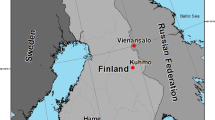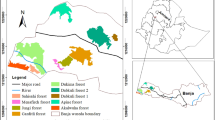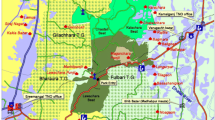Abstract
The effects of anthropogenic disturbances on forest structure and plant diversity of secondary forest ecosystems were evaluated based on the classification by site factors in the montane regions of northeastern China. Forty-five sample plots containing 720 sub-plots of overstory species (8 m × 8 m), 1,440 quadrats of understory species (2 m × 2 m), and 1,440 quadrats of herbaceous layer species (1 m × 1 m) were clustered into five groups (G1, G2, G3, G4 and G5) by site variables with Hierarchical Cluster Analysis. Meanwhile, the disturbance levels corresponding to the five groups were determined according to the factors influencing human disturbances (D0-G2, D1-G1, D2-G3, D3-G5, and D4-G4). Species diversities of overstory, understory, herbaceous layer and overall species were evaluated using species number, Margalef index, Pielou index, Shannon–Wiener index, and Simpson index; and β-diversities (Whittaker index, Cody index). Basal area of stands exhibited a decreasing trend along the disturbance level due to a gradual increase in the extraction of timber by the human disturbances. The indices of species diversity suggested that overstory and understory species were distributed evenly among the groups or disturbance levels. There were no absolutely dominant tree species in the secondary forest ecosystems. The differences in site factors and the current disturbance intensities were not intense enough to lead to loose changes in overstory and understory species. The species diversity indices exhibited the maximum values at D3 (G5) for herbaceous layer species; this may suggest that the current disturbance intensities were intense enough to lead the changes of herbaceous layer species. Three rare and endangered species (Juglans mandshurica, Fraxinus mandshurica and Acanthopanax senticosus) were found within the secondary forests. These rare and endangered species appeared in each clustered group or disturbance level, which suggested that the current disturbance intensity in the study area was not strong enough to influence the distribution of rare and endangered species. The current disturbances in the secondary forests may not lead to a decrease in stability and complexity of the overstory and understory species, but the higher disturbance level may be intense enough to change the habitat fitness for the herbaceous species.



Similar content being viewed by others
References
Berger WH, Parker FL (1970) Diversity of planktonic forminifera in deep-sea sediments. Science 168:1345–1347
Buckley DS, Crow TR, Nauertz EA, Schulz KE (2003) Influence of skid trails and haul roads on understory plant richness and composition in managed forest landscapes in Upper Michigan, USA. For Ecol Manage 175:509–520
Burnham RJ (2004) Alpha and beta diversity of Lianas in Yasuní, Ecuador. For Ecol Manage 190:143–55
Burslem DFRP, Whitmore TC (1999) Species diversity susceptibility to disturbance and tree population dynamics in tropical rainforest. J Veg Sci 10:767–776
Cao W, Li JY (2003) Natural distribution for plant of Changbai Mountain in China. Northeast University Press, Shenyang, China (in Chinese)
Chen DK, Zhou XF, Zhu N (1994) Natural secondary forest-structure, function, dynamic and management. Northeast Forestry University Press, Harbin, China (in Chinese)
Chen XW, Li BL, Lin ZS (2003) The acceleration of succession for the restoration of the mixed-broadleaved Korean pine forests in Northeast China. For Ecol Manage 177:503–514
Chiarucci A, Bonini I (2005) Quantitative floristics as a tool for the assessment of plant diversity in Tuscan forests. For Ecol Manage 212:160–171
Collins SL, Glenn SM, Gibson DJ (1995) Experimental analysis of intermediate disturbance and initial floristic composition: decoupling cause and effect. Ecology 76:486–492
Compilation Group of China’s Biodiversity (1998) China’s biodiversity: a country study. China Environmental Science Press, Beijing, China (in Chinese)
Connell JH (1978) Diversity in tropical rain forest and coral reefs. Science 199:1302–1310
Elliott KJ, Hewitt D (1997) Forest species diversity in upper elevation hardwood forests in the southern Appalachian Mountains. Castanea 62:32–42
Fulbright TE (2004) Disturbance effects on species richness of herbaceous plants in a semi-arid habitat. J Arid Environ 58:119–133
Hao ZQ, Guo SL, Cao T (2002) Plant diversity and distribution patterns in Changbai Mountain. Liaoning Science and Technology Press (in Chinese)
Hill MO (1973) Diversity and evenness: a unifying notation and its consequences. Ecology 54:427–432
Hu LL, Mao ZH, Zhu JJ, Liu ZG, Chen GH, Zhang LJ (2005) Classification and ordination of secondary forests in Montane Zone of eastern Liaoning Province (in Chinese with English abstract). Acta Ecol Sinica 25:2848–2854
Huang SN, Wang BS (2000) Study on community dynamics of secondary tropical forests: review and prospects (in Chinese with English abstract). World For Res 13(6):7–13
Kanowski J, Catterall CP, Wardell-Johnson GW (2005) Consequences of broadscale timber plantations for biodiversity in cleared rainforest landscapes of tropical and subtropical Australia. For Ecol Manage 208:359–372
Kenkel NC, Orloct L (1986) Applying metric and non-metric multidimensional scaling to ecological studies: some new results. Ecology 67:918–928
Levitus S, Antonov JI, Wang J, Delworth TL, Dixon KW, Broccoli AJ (2001) Anthropogenic warming of earth’s climate system. Science 292:267–270
Li WH (2004) Degradation and restoration of forest ecosystems in China. For Ecol Manage 201:33–41
Li ZH, Luo P (2005) SPSS for Windows. Version 2. Publishing House of Electronics Industry, Beijing, China (in Chinese)
Li XF, Zhu JJ, Wang QL, Liu ZG (2005) Forest damage induced by wind/snow: a review. Acta Ecol Sinica 25:148–157
Lindenmayer DB, Franklin JF (2002) Conserving forest biodiversity, a comprehensive multiscaled approach. Island Press, Washington DC, USA
Ma KP (1994) Measurement of biotic community diversity I: measurement of α-diversity (1) (in Chinese with English abstract). Chin Biodivers 2:162–168
Ma KP, Liu YM (1994) Measurement of biotic community diversity I: measurement of α-diversity (2) (in Chinese with English abstract). Chin Biodivers 2:231–239
Ma KP, Liu CR (1995) Measurement method of biotic community diversity II: measurement method for β-diversity (in Chinese with English abstract). Chin Biodivers 3:38–43
Magurran AE (1988) Ecological diversity and its measurement. Princeton University Press, Princeton, NJ, USA
Mao ZH, Zhu JJ (2006) Effects of disturbances on species composition and diversity of plant communities (in Chinese with English abstract). Acta Ecol Sin 26:2695–2701
Miller TE (1982) Community diversity and interactions between the size and frequency of disturbance. Am Nat 120:533–536
Noble IR, Dirzo R (1997) Forests as human-dominated ecosystems. Science 277:522–525
Pandey SK, Shukla RP (1999) Plant diversity and community patterns along the disturbance level in plantation forests of sal (Shorea robusta Gaertn). Curr Sci 77:814–818
Pascarella JB, Aide TM, Serrano MI, Zimmerman JK (2000) Land use history and forest regeneration in the Cayey mountains, Puerto Rico. Ecosystems 3:218–228
Pascarella JB, Aide TM, Zimmerman JK (2004) Short-term response of secondary forests to hurricane disturbance in Puerto Rico, USA. For Ecol Manage 199:379–393
Peltzer DA, Bast ML, Wilson SD, Gerry AK (2000) Plant diversity and tree responses following contrasting disturbances in boreal forest. For Ecol Manage 127:191–203
Phillips OL, Hall P, Gentry AH, Sawyer SA, Vásquez MR (1994) Dynamics and species richness of tropical rain forests. Proc Natl Acad Sci USA 91:2805–2809
Phillips OL, Hall P, Gentry AH, Sawyer SA, Vásquez MR (1997) Species richness, tropical forest dynamics and sampling: response to Sheil. Oikos 79:183–190
Phillips OL, Vásquez MR, Arroyo L, Baker TR, Killeen T, Lewis SL, Malhi Y, Monteaguo MA, Neill D, Núñez VP, Alexiades M, Ceron C, DiFiore A, Erwin T, Jardim A, Palacios W, Saldias M, Vinceti B (2002) Increasing dominance of large lianas in Amazonian forests. Nature 418:770–774
Ramirez-Marcial N, Gonzalez-Espinosa M, Williams-Linera G (2001) Anthropogenic disturbance and tree diversity in montane rain forests in Chiapas, Mexico. For Ecol Manage 154:311–326
Sagar R, Raghubanshi AS, Singh JS (2003) Tree species composition, dispersion and diversity along a disturbance level in a dry tropical forest region of India. For Ecol Manage 186:61–71
Saito T (1996) Relationship between the profiles of wind velocity and gap fraction recorded by hemispherical photographs in a deciduous forest (in Japanese with English abstract). J Jpn For Soc 78:384–389
Schumann ME, White AS, Witham JW (2003) The effects of harvest-created gaps on plant species diversity, composition, and abundance in a Maine oak-pine forest. For Ecol Manage 176:543–561
Schwilk DW, Keeley JE, Bond WJ (1997) The intermediate disturbance hypothesis does not explain fire and diversity pattern in fynbos. Plant Ecol 132:77–84
Shannon CE, Weaver W (1949) The mathematical theory of communication. University of Illinois Press, Urbana, IL, USA
Sheil D (1999) Tropical forest diversity, environmental change and species augmentation: after intermediate disturbance hypothesis. J Veg Sci 10:851–860
Singh JS (2002) The biodiversity crisis: a multifaceted review. Curr Sci 82:638–647
State Environmental Protection Administration of China (SEPAC) (1987) The list of rare and endangered plants in China (first issue). Science Press, Beijing, China (in Chinese)
Tárrega R, Calvo L, Marcos E, Taboada A (2006) Forest structure and understory diversity in Quercus pyrenaica communities with different human uses and disturbances. For Ecol Manage 227:50–58
Wang JH, Ye LQ (2001) Ordination and environmental interpretation of the evergreen broad-leaved forest community in Simian Mountain, Chongqing. J Fuling Nor Colle 17:83–87
Wilson SD, Tilman D (1991) Interactive effects of fertilization and disturbance on community structure and resource availability in an old-field plant community. Oecologia 88:61–71
Wright SJ (2002) Plant diversity in tropical forests: a review of mechanisms of species coexistence. Oecologia 130:1–14
Zhang PC, Shao GF, Zhao G (2000) China’s forest policy for the 21st century. Science 288:2135–2136
Zhu JJ (2002) A review on fundamental studies of secondary forest management (in Chinese with English abstract). Chin J Appl Ecol 13:1689–1694
Zhu JJ, Liu ZG (2004) Review on disturbance ecology of forests (in Chinese with English abstract). Chin J Appl Ecol 15:1703–1710
Zhu JJ, Matsuzaki T, Gonda Y (2003) Optical stratification porosity as a measure of vertical canopy structure in a Japanese pine coastal forest. For Ecol Manage 173:89–104
Zhu JJ, Li XF, Liu ZGs, Cao W, Gonda Y, Matsuzaki T (2006) Factors affecting the snow/wind induced damage of a montane secondary forest in northeastern China. Silva Fenn 40:37–51
Acknowledgments
This study was supported by the 100-young-researcher-project of Chinese Academy of Sciences and National Nature Scientific Foundation Projects of China (30371149, 30671669). We would like to acknowledge the anonymous referees and the editors for their valuable criticisms and detail revisions concerned to this manuscript. Thanks are due to Professor Li Jiyun and Dr. Cao Wei from Institute of Applied Ecology, Chinese Academy of Sciences for their help in identifying the herb species.
Author information
Authors and Affiliations
Corresponding author
Electronic supplementary material
Below is the link to the electronic supplementary material.
About this article
Cite this article
Zhu, J., Mao, Z., Hu, L. et al. Plant diversity of secondary forests in response to anthropogenic disturbance levels in montane regions of northeastern China. J For Res 12, 403–416 (2007). https://doi.org/10.1007/s10310-007-0033-9
Received:
Accepted:
Published:
Issue Date:
DOI: https://doi.org/10.1007/s10310-007-0033-9




